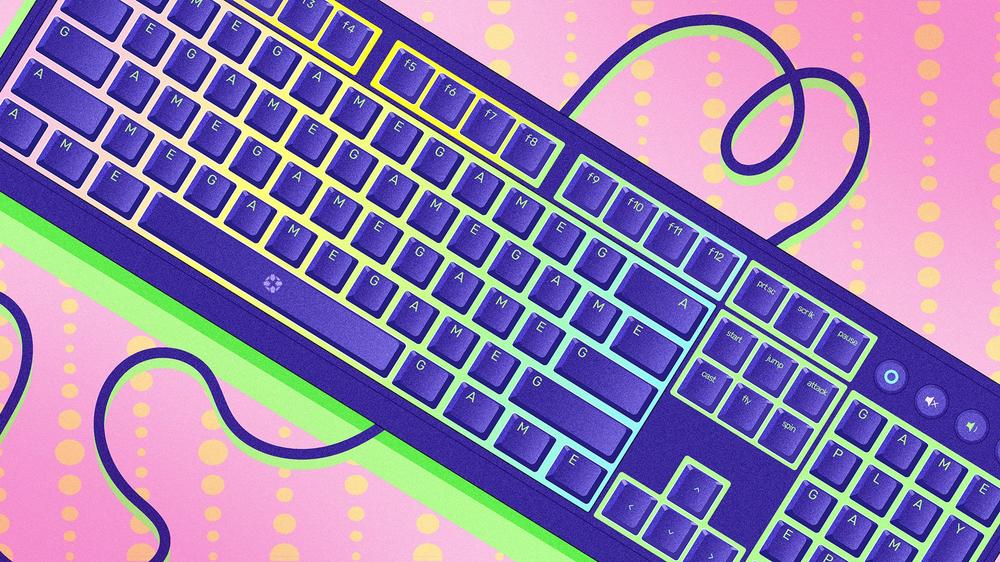More so than trying to pick out the best gaming mouse or best gaming headset, finding the right keyboard for yourself has a lot to do with your preferences. Everything from its overall layout (tenkeyless or full-sized), mechanical switches, and additional features: These are all aspects that come down to personal taste. Even with my own preferences accounted for, several factors still contribute to how a gaming keyboard performs and it’s best to know these details before making an investment – these things can be pretty expensive, after all. If anything, it’s crucial to know what a keyboard offers, and in this guide, I’ve outlined the important aspects to my favorites I’ve used thus far.
Luckily for you, I’ve had my hands on many keyboards over the years and several newly released ones. That means all my recommendations come from first-hand experience, and all the keyboards listed here are ones I can vouch for. I’ll dive deep into how each keyboard’s switches perform in competitive gaming scenarios and what its keystrokes feel like when typing all day – not all keyboards are the same, considering how they’re constructed contributes to that specific feel. Extra features like Razer’s Command Dial or the SteelSeries OLED control panel are nice add-ons, but things like that are often tied to software apps, and that’s another thing to consider if you’re looking for a highly customizable keyboard. Something as seemingly innocuous as keycaps can also be a factor to how a keyboard performs. There are a ton of nuances to gaming keyboards, and I’ve done the work in my reviews and in this guide to make sure you make an informed purchasing decision.
TL;DR: These Are the Best Gaming Keyboards:
Because there are so many styles of keyboards, I’ve broken down my recommendations into a handful of categories. It also gives me the opportunity to point to multiple products from different manufacturers – otherwise, I would just sing the praises of my current favorite in the SteelSeries Apex Pro. Even so, there’s a lot to love about every keyboard here, some of which execute on specific aspects better than others, or could fit your needs and preferences better. For example, another current favorite, the MonsGeek FUN60 Ultra TMR, takes the top spot for best compact 60% keyboard because of its affordability and fantastic magnetic switches. Meanwhile I’d recommend the Razer BlackWidow V4 Low-Profile if you’re looking for a compact keyboard since its slim frame keeps a small footprint yet doesn’t sacrifice performance. And if you’re just looking for something quality on a budget, I can say the Keychron C3 Pro is super impressive for its price. If it’s not evident by now, I’m fascinated by the little details that go into them, so let’s go through my top picks for the best gaming keyboards.
Best Overall Gaming Keyboard
Best High-End Gaming Keyboard
Best Budget Gaming Keyboard
Best Compact (60%) Gaming Keyboard
Best Tenkeyless (75%) Gaming Keyboard
Best 96% Layout Gaming Keyboard
Best Full-Sized Gaming Keyboard
Best Low-Profile Gaming Keyboard
Best Wired Gaming Keyboard
Best Customizable Gaming Keyboard
What are the advantages between different mechanical switches?
At the heart of finding the right gaming keyboard is picking out the right mechanical switch to go with it – or optical switch, or Hall Effect switch? In a post-buckling spring keyboard world, Cherry had dominated the mechanical switch market and many manufacturers relied on them to supply them for its gaming keyboards. But more companies have developer proprietary switches, and while there were mixed results early on, it’s gotten to the point where Logitech or Razer switches compete as some of the best available. And lesser-known makers like Gateron and Kailh Box are just as competitive when it comes to their own mechanical switches. Meanwhile, the advent of optical and Hall Effect switches are a recent trend toward using light and magnets, respectively, instead of physical mechanisms.
That’s a brief history lesson on switches, but if you’re not already dead set with your preferences, here’s a breakdown of the different kinds of switches you’ll find on gaming keyboards. There are three main styles: linear, tactile, clicky – and if you see an optical or Hall Effect switch, chances are they are also linear (especially because their actuation points are adjustable). Linear means there is no physical feedback on the actuation point, giving a smooth, often clean keystroke. Tactile switches have a slight bump at the actuation point to offer some sort of feedback that can help you get a better feel when you’re hitting your inputs. Clicky switches are much louder and have a full physical feedback at the actuation point, which some people love for typing in particular (I do find clicky switches to get in the way of faster keystrokes, but that’s just me).
Another thing to note is actuation point, travel distance, and actuation force. The actuation point is the distance in the keystroke when the keyboard will send the input to your system. Standard mechanical switches use a 2.0mm actuation point, which works well. More competitive-minded switches tend to go shorter, somewhere around 1.5mm so you can technically send out your input quicker – the tradeoff being that you can accidentally register errant keystrokes if you aren’t careful. Travel distance is the point at which a keystroke will bottom out, and this is usually proportional to the actuation point. For example, if the actuation point is 2.0mm then the travel distance will probably be 4.0mm, and a switch with a 1.5mm actuation point may have a travel distance of 3.5mm – again, the idea is to get your keystrokes registered faster. Actuation force is the physical effort it takes to push the key down, typically measured in grams (g) or centinewtons (cN), which are largely the same. Typical switches have a 45g actuation force, but if you prefer a more firm press, you can find ones with a 50g actuation force, or if you're like me you can find something lighter on the fingers at around 40g or 38g.
Should I go with a TKL, compact, or full-sized keyboard?
A theme throughout this guide is personal preference, and none more applicable than when talking about layout and size. Full-sized keyboards give you all 104 standard keys and take up the most desk space, of course. This also affords them to tack on additional features like media controls, macro buttons, and whatnot. There are also the neatly packed 96% keyboards that retain all the necessary keys while crunching them into a slightly more compact, if not crowded, layout. If you use the number pad and center column often, and don’t care about the footprint, you’ll probably want to go with a full keyboard.
Tenkeyless (TKL) layouts are just as common now – I guess a lot of folks just don’t have love for the number pad anymore. But having a high-performance gaming keyboard and extra desk space for your mouse goes hand-in-hand. Many top-end TKL keyboards are adding useful features such as Razer’s Command Dial or the SteelSeries OLED panel to make up for some of the utility you sacrifice. And at the end of the day, it’s about how these keyboards perform in game, which largely comes down to mechanical switches, build quality, and features that help get inputs out as fast and accurately as possible.
If you really want to shrink things down, go for a compact 60% mini keyboard. I do have a soft spot for them, but at this point, you’re nixing the entire center column as well as the function keys. Those keys are useful, and that's a compromise you make for the cuteness of a mini keyboard. I wouldn’t necessarily recommend them if you really want these functions or play games that rely on extra keys or macros, but so long as the board is built well and has the right switch, it’ll perform as well as any other sized keyboard.
Should I go wired or wireless for a gaming keyboard?
Wireless connectivity is arguably more important for gaming mice and gaming headsets since those are peripherals that are subject to a lot of movement. It gives them a certain advantage and convenience in exchange for managing battery life (and even that has improved dramatically in recent years). If you ask me, wireless is more of a nice-to-have for a gaming keyboard. It’s certainly more common to find wireless keyboards, but in the gaming space, you’ll often find wired and wireless versions of the same keyboard, and you’ll save a bit of money going with the wired version.
A prime example of this is when looking at the SteelSeries Apex Pro TKL – a fantastic tenkeyless keyboard, and my top recommendation. The wireless version retails for $269.99 while the wired model goes for $219.99 at regular price. You can save $50 and get what’s essentially the same keyboard with all the essential features intact. You’ll find a similar price gap between wired and wireless mice, which I’d say is worth investing in since swiping a mouse around feels much more natural without a cord attached. You can’t say the same about a keyboard (but I am still willing to spend the extra for it).
If you’re concerned about input latency, you need not worry nowadays. As is the case with gaming mice, wireless tech has advanced to the point of it being a moot point. You’ll see labels like Lightspeed from Logitech or HyperSpeed from Razer, which are fancy names for the wireless tech built into their products, but these are legitimately high-performing features that have raised the bar for wireless gaming peripherals. And although it’s more relevant for mice, higher polling rates are more commonly integrated through wireless dongles – which speaks more to how far wireless gear has come.

 “Let’s go to McDonald’s”: Dad throws tantrum after daughter tricks him into thinking In-N-Out burger is vegan
“Let’s go to McDonald’s”: Dad throws tantrum after daughter tricks him into thinking In-N-Out burger is vegan